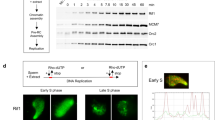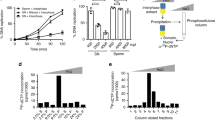Abstract
In eukaryotic cells, chromosomal DNA replication begins with the formation of pre-replication complexes at replication origins. Formation and maintenance of pre-replication complexes is dependent upon CDC6 (ref. 1), a protein which allows assembly of MCM2–7 proteins2,3,4, which are putative replicative helicases5. The functional assembly of MCM proteins into chromatin corresponds to replication licensing. Removal of these proteins from chromatin in S phase is crucial in origins firing regulation6. We have identified a protein that is required for the assembly of pre-replication complexes, in a screen for maternally expressed genes in Xenopus. This factor (XCDT1) is a relative of fission yeast cdt1, a protein proposed to function in DNA replication7, and is the first to be identified in vertebrates. Here we show, using Xenopus in vitro systems, that XCDT1 is required for chromosomal DNA replication. XCDT1 associates with pre-replicative chromatin in a manner dependent on ORC protein and is removed from chromatin at the time of initiation of DNA synthesis. Immunodepletion and reconstitution experiments show that XCDT1 is required to load MCM2–7 proteins onto pre-replicative chromatin. These findings indicate that XCDT1 is an essential component of the system that regulates origins firing during S phase.
This is a preview of subscription content, access via your institution
Access options
Subscribe to this journal
Receive 51 print issues and online access
$199.00 per year
only $3.90 per issue
Buy this article
- Purchase on Springer Link
- Instant access to full article PDF
Prices may be subject to local taxes which are calculated during checkout




Similar content being viewed by others
References
Cocker,J. H., Piatti,S., Santocanale,C., Nasmyth,K. & Diffley,J. F. X. An essential role for the Cdc6 protein in forming the pre-replicative complexes of budding yeast. Nature 379, 180–182 ( 1996).
Tanaka,T., Knapp,D. & Nasmyth,K. Loading of an MCM protein onto DNA replication origins is regulated by Cdc6p and CDKs. Cell 90, 649–660 (1997).
Aparicio,O. M., Weinstein,D. M. & Bell, S. P. Components and dynamics of DNA replication complexes in S. cerevisiae: redistribution of MCM proteins and Cdc45p during S phase. Cell 91, 59–69 (1997).
Coleman,T. R., Carpenter,P. B. & Dunphy, G. The Xenopus Cdc6 protein is essential for the initiation of a single round of DNA replication in cell-free extracts. Cell 87, 53–63 ( 1996).
Ishimi,Y. A DNA helicase activity is associated with an MCM4, -6 and -7 protein complex. J. Biol. Chem. 272, 24508– 24513 (1997).
Liang,C. & Stillman,B. Persistent initiation of DNA replication and chromatin-bound MCM proteins during the cell cycle in cdc6 mutants. Genes Dev. 11, 3375–3386 (1997).
Hofmann,J. F. X. & Beach,D. cdt1 is an essential target of the Cdc10/Sct1 transcription factor: requirement for DNA replication and inhibition of mitosis. EMBO J. 13, 425 –434 (1994).
Moreau,J., Iouzalen,N. & Méchali, M. Isolation of cDNAs from maternal mRNAs specifically present during early development. Mol. Rep. Dev. 41 , 1–7 (1995).
Fernandez Sarabia,M. J., McInerny,C., Harris,P., Gordon,C. & Fantes,P. The cell cycle genes cdc22+ and suc22+ of the fission yeast Schizosaccharomyces pombe encode the large and small subunits of ribonucleotide reductase. Mol. Gen. Genet. 238, 241–251 (1993).
Kelly,T. J. et al. The fission yeast cdc18+ gene product couples S phase to START and mitosis. Cell 74, 371– 382 (1993).
Carpenter,P. B., Mueller,P. R. & Dunphy, W. Role for a Xenopus Orc2-related protein in controlling DNA replication. Nature 379, 357– 360 (1995).
Mechali,M. & Harland,R. M. DNA synthesis in a cell-free system from Xenopus eggs: priming and elongation on single-stranded DNA in vitro. Cell 30, 93– 101 (1982).
Almouzni,G. & Mechali,M. Assembly of spaced chromatin promoted by DNA synthesis in extracts from Xenopus eggs. EMBO J. 7, 665–672 ( 1988).
Blow,J. J. Preventing re-replication of DNA in a single cell cycle: evidence for a replication licensing factor. J. Cell Biol. 122, 993 –1002 (1993).
Coue,M., Amariglio,F., Maiorano,D., Bocquet,S. & Méchali,M. Evidence for different MCM subcomplexes with differential binding to chromatin in Xenopus. Exp. Cell Res. 245, 282–289 (1998).
Coué,M., Kearsey,S. E. & Méchali, M. Chromatin binding, nuclear localization and phosphorylation of Xenopus cdc21 are cell-cycle dependent and associated with the control of initiation of DNA replication. EMBO J. 15, 1085–1097 (1996).
Rowles,A. et al. Interaction between the origin recognition complex and the replication licensing system in Xenopus. Cell 87, 287–296 (1996).
Romanowski,P., Madine,M. A., Rowles,A., Blow,J. J. & Laskey,R. A. The Xenopus origin recognition complex is essential for DNA replication and MCM binding to chromatin. Curr. Biol. 6, 1416–1425 (1996).
Chong,J. P., Mahbubani,H. M., Khoo,C. -Y. & Blow,J. J. Purification of an MCM-containing complex as a component of the DNA replication licensing system. Nature 375, 418– 421 (1995).
Rowles,A., Tada,S. & Blow,J. J. Changes in association of the Xenopus origin recognition complex with chromatin on licensing of replication origins. J. Cell Sci. 112, 2011–8 (1999).
Perkins,G. & Diffley,J. F. Nucleotide-dependent prereplicative complex assembly by Cdc6p, a homolog of eukaryotic and prokaryotic clamp-loaders. Mol. Cell 2, 23–32 (1998).
Vuillard,L., Rabilloud,T. & Goldberg, M. E. Interactions of non-detergent sulfobetaines with early folding intermediates facilitate in vitro protein renaturation. Eur. J. Biochem. 256, 128– 135 (1998).
Menut,S., Lemaître,J. M., Hair, A. & Méchali,M. in Advances in Molecular Biology: A Comparative Methods Approach to the Study of Ooocytes and Embryos (ed. Richter, J. D.) 198– 226 (Oxford Univ. Press, 1999).
Murray,A. W. Cell cycle extracts. Methods Cell Biol. 36, 581–605 (1991).
Maiorano,D., Lemaître,J-M. & Méchali,M. Step-wise, regulated chromatin assembly of MCM2-7 proteins. J. Biol. Chem. (in the press).
Acknowledgements
We thank S. Bocquet for technical assistance in the raising of antibodies; S. Cotterill for the cdc6 antibody; J. Blow and A. Rowles for the ORC1 antibody; and C. Jaulin, D. Fisher and J.-M. Lemaître for helpful technical tips. This work has been supported by grants from ARC and Ligue Nationale contre le Cancer. D. M. was supported by an EC fellowship (Biomedicine and Health) and a grant from Fondation pour la Recherche Médicale.
Author information
Authors and Affiliations
Corresponding author
Rights and permissions
About this article
Cite this article
Maiorano, D., Moreau, J. & Méchali, M. XCDT1 is required for the assembly of pre-replicative complexes in Xenopus laevis. Nature 404, 622–625 (2000). https://doi.org/10.1038/35007104
Received:
Accepted:
Issue Date:
DOI: https://doi.org/10.1038/35007104
This article is cited by
-
The SMC5/6 complex subunit MMS21 regulates stem cell proliferation in rice
Plant Cell Reports (2023)
-
MYC: a multipurpose oncogene with prognostic and therapeutic implications in blood malignancies
Journal of Hematology & Oncology (2021)
-
Depletion of NK6 Homeobox 3 (NKX6.3) causes gastric carcinogenesis through copy number alterations by inducing impairment of DNA replication and repair regulation
Oncogenesis (2021)
-
Premature activation of Cdk1 leads to mitotic events in S phase and embryonic lethality
Oncogene (2019)
-
Strategic role of the ubiquitin-dependent segregase p97 (VCP or Cdc48) in DNA replication
Chromosoma (2017)
Comments
By submitting a comment you agree to abide by our Terms and Community Guidelines. If you find something abusive or that does not comply with our terms or guidelines please flag it as inappropriate.



